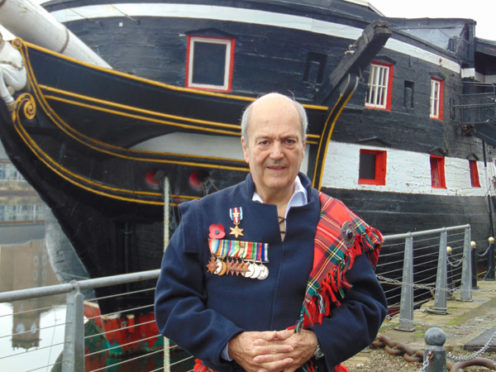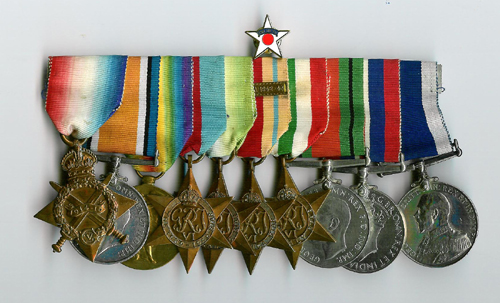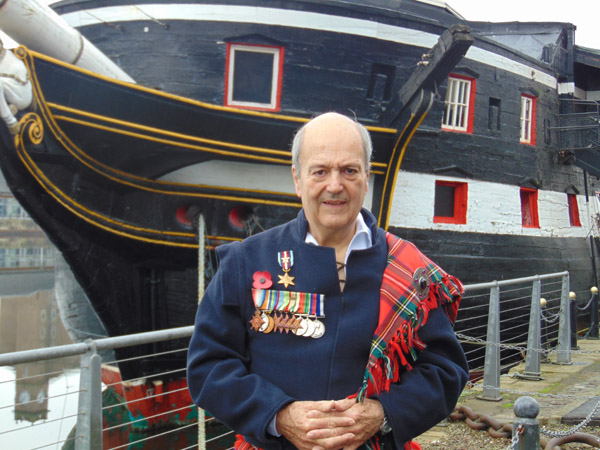In the penultimate excerpt from The Courier’s book The First World War – The Scottish Soldier’s Story, we look at a tale of courage from the Battle of Jutland.
Former Courier reporter, TV producer and director Michael Mulford reflects on his father’s experiences at the Battle of Jutland.
“Oh, hear us when we cry to Thee
For those in peril on the sea.”
Even with his lovely singing voice, Able Seaman Mark Mulford must have struggled to join his shipmates as they sang the Navy Hymn aboard HMS Malaya in the North Sea on that day in June 1916. He would not have known it, but the 19-year-old sailor had just taken part in what historians would judge the last great sea battle of all time. He would not have been certain where Jutland was. One thing was for sure – he had just witnessed naval warfare in all its raw, brutal horror.
The first time I heard Eternal Father Strong to Save was at my father’s funeral in Dundee 52 years later. My mother, Anna, chose the hymn. She knew what it meant to sailors, and what being the watch ashore was – bringing up a family while her husband was far away on duty. I was greatly touched when my father’s cortege reached Dundee Crematorium to find a Royal Navy guard of honour waiting. My father’s obituary in The Courier carried the headline “Jutland veteran dead”.
It was only at that sad time I began to learn what the Battle of Jutland was about, and how my father was one of thousands who found themselves amid a living nightmare. He learned quickly that when the enemy guns flashed, you counted 30 seconds and breathed a sigh of relief when the giant shells did not find their targets. When they did, the carnage that followed in the ships which took direct hits was indescribable.
I learned German at Harris Academy and the phrase Der Tag meant no more than simply “the day”. In 1916 it had a much more jingoistic explanation. It was to be the long-awaited day when the 151 ships of the Grand Fleet of the Royal Navy and the 99-strong High Seas Fleet of Germany finally went head to head to prove who was superior.
The place they chose to fight it out was the North Sea off Jutland, Denmark.
Thousands of sailors from the battle would not see home or family again. Hundreds would be blinded, maimed, hideously burned or have their minds destroyed by shellshock.
HMS Malaya was part of the 5th Battle Squadron made up of Queen Elizabeth class super-dreadnoughts.
She could fire shells weighing 2,000lb more than 14 miles.
Malaya, under the command of Captain Algernon Boyle, sailed from Rosyth on Tuesday May 30, leaving the sight of the Forth Bridge behind to join with the other Royal Navy ships.
Der Tag had arrived. How exciting that must have seemed to AB Mulford and his shipmates. They could not have known that over the next two days they would go to hell and back. Those who did that were the lucky ones.
Part of the battle was called The Run to the North. This left Malaya vulnerable as the last ship in the line. The bugles sounded “action” and at 1730hrs on that fateful last day in May, Malaya took a direct hit which killed the entire crew of one of the guns. It also started a flash fire which ignited cordite, causing terrible burns, and which raged through a large part of the ship for hours. But Malaya, despite taking many more hits, fought on in finest traditions of the Service. When the German destroyer S35 pushed her luck and got within range, Malaya’s guns hit her with shells which tore her apart. She sank with the loss of all 88 hands, including survivors she had rescued from other German ships which had been sunk.
When the battle was over Malaya called the muster. The grim reality of warfare had wreaked death and destruction. The silences in the roll call meant another shipmate gone.
In all, 63 brave men made the supreme sacrifice. Another 68 were grievously wounded and Malaya’s three surgeons worked non-stop for 24 hours until their legs would not support them any longer.
My father then witnessed a ceremony which no training could have prepared him for. He watched, as two by two, according to a tradition at least as old as the Royal Navy herself, the bodies of the men who had died were committed to the deep. Hammocks were used with the bodies, or parts of bodies, sewn inside. Anything which could be used to weigh them down was deployed. As the last of the bodies slid from mess tables on the deck through the grating and into the North Sea, the buglers sounded The Last Post.
Then came the hymn. I openly confess I have to fight back tears every time I sing it. Heaven knows how a 19-year-old coped on the deck of a battered, mangled and blackened warship as 63 bodies were sent on their final journey.
Historians called Jutland the last great sea battle. It may have been great in terms of scale but I am left thinking that in human terms it was anything but.
Buy your copy
First World War – The Scottish Soldier’s Story, is a 150-page compilation of The Courier’s commemorative special First World supplements 1914-1918.
£11.99 with free p&p, available from www.dcthomsonshop.co.uk or call 0800 318 846 (Freephone), quoting CSOST, lines open Mon-Fri 8am-6pm, Sat 9am-5pm.
Also available from the DC Thomson Shop, Albert Square, Dundee DD1 1DD













